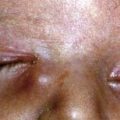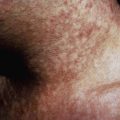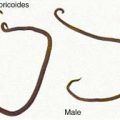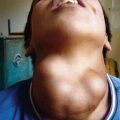Chapter 109 The Breast
Breast development is one of the first obvious signs of puberty in the adolescent female. It is clinically important to distinguish normal progression of breast development, some variation in that progression, or a definable disorder. Normal breast development during puberty is described using a Sex Maturity Rating scale of 1-5, as the breast becomes more mature (Chapter 104).
Male Disorders
Pubertal gynecomastia (Chapter 579), occurring in up to 60% of normal adolescent males, has long been attributed to a transient imbalance of estrogen and androgen concentrations. With typical onset between chronological ages of 10 and 13 yr, it usually regresses over several months. On physical exam, it is important to distinguish between glandular tissue (true gynecomastia) and adipose tissue (pseudogynecomastia). Reassurance and continued observation are recommended in most cases. Rarely is it of such magnitude or persistence as to warrant surgery. Several hormonal therapies have been utilized for the treatment of gynecomastia; however, none has received approval for use in adolescents by the U.S. Food and Drug Administration. Nonpubertal gynecomastia with hypogonadism is associated with Klinefelter syndrome and places a patient at a higher risk of breast cancer (Chapter 577). Other conditions associated with nonpubertal gynecomastia are secondary to endocrine disorders, neoplasms, chronic disease, trauma, and medications as well as drugs of abuse (Table 109-1).
| Antiandrogens | Bicalutamide, flutamide, finasteride, spironolactone |
| Antibiotics | Isoniazid, ketoconazole, metronidazole |
| Antihypertensives | Amlodipine, captopril, diltiazem, enalapril, nifedipine, verapamil |
| GI agents | Cimetidine, ranitidine, omeprazole |
| Hormones | Androgens, anabolic steroids, chorionic gonadotropin, estrogens, growth hormone |
| Illicit drugs | Alcohol, amphetamines, heroin, marijuana, methadone |
| Psychiatric | Diazepam, haloperidol, phenothiazines, tricyclic antidepressants |
| Others | Antiretrovirals, digitalis, fibrates, methotrexate, statins, GnRH agonists |
GI, gastrointestinal; GnRH, gonadotropin releasing hormone.
From Eckman A, Dobs A: Drug-induced gynecomastia, Expert Opin Drug Saf 2:691–702, 2008.
Eckman A, Dobs A. Drug-induced gynecomastia. Expert Opin Drug Saf. 2008;7:691-702.
Joffe A. Gynecomastia. In: Neinstein LS, Gordon CM, Katzman DK, et al, editors. Adolescent health care: a practical guide. ed 5. Philadelphia: Lippincott Williams & Wilkins; 2008:180-184.
Greydanus DE, Matytsina L, Gains M. Breast disorders in children and adolescents. Prim Care. 2006;33:455-502.
Nordt CA, Divasta AD. Gynecomastia in adolescents. Curr Opin Pediatr. 2008;20:375-382.
Shulman DI, Francis GL, Palmert MR, et al. Use of aromatase inhibitors in children and adolescents with disorders of growth and adolescent development. Pediatrics. 2008;121:e975-e983.






